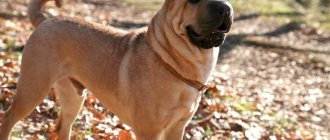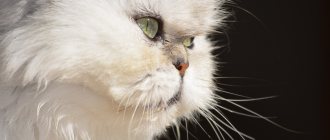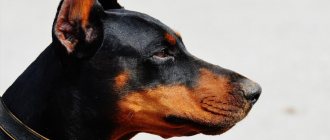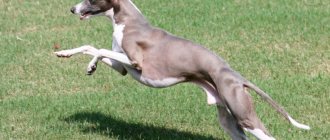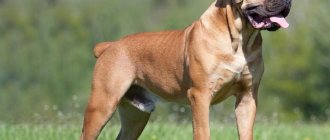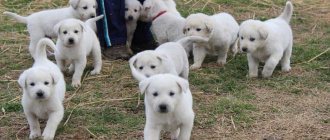Breed characteristics
| Short description | |
| Origin: | Middle East (country not specified) |
| Conditions of detention: | Country housing |
| Purpose: | Hunting |
| Color: | Anyone except brindle |
| Wool length: | Medium length, with fringes |
| Adult dog size: | The height of males is from 58 to 68 cm at the withers, females are slightly lower. Weight parameters have not been set. |
| Average life expectancy: | 12-15 years |
| Walk: | 2 times a day |
| Physical activity needs: | High level |
| Fédération Cynologique Internationale (FIC) classification: | Group No. 10 Greyhounds Section No. 1 Long-haired greyhounds or greyhounds with fringes |
| Puppy price: | On average: 25,000-70,000 rubles.
|
Pros and cons of the breed
Saluki is a dog with a difficult temperament. Her habits are aristocratic, her movements are graceful. If she recognizes her owner, she will be devoted to him for the rest of her life.
Before you buy a puppy of this breed, weigh your options. The Saluki requires a lot of attention, it needs space and freedom to run. If she is not provided with proper conditions of detention, she will suffer.
Below are the main pros and cons of the Persian Greyhound.
Advantages:
1. Exotic appearance. 2. Devotion. 3. Endurance, speed. 4. Unpretentiousness in care and food. 5. Absence of unjustified aggression. 6. Instinct, perfect hunter skills. 7. Good health, excellent genetic inheritance.
History of the origin of the species
The first mention of dogs of this type dates back to 3500 BC . The exact country of origin is not known for certain. It is noted that the homeland of these animals is the Middle East. Presumably the name of the breed comes from the city of Saluk, located in this territory. Dogs accompanied the nomadic Bedouins. The appearance of the animals changed depending on the habitat.
Dogs of similar appearance were also found in Egypt and Mesopotamia, depicted on frescoes and in tombs. The country's ruling elite used animals for entertainment - hunting birds, gazelles, rabbits and antelopes. At the same time, the dogs were delivered to the event site on horseback, along with their owners.
The qualities that underlay the selection were speed of movement and visual acuity. Dogs reach speeds of up to 70 km/h and are able to pursue a spotted target for a long time. It is unknown what breeds were used to create the Saluki, but research has revealed that they share genes with the wolf.
Animals of this species were considered very valuable; they were not sold, but could be given as gifts. Presumably this is how they got to China. It is known that the painting from 1427 depicts the emperor of the country along with a dog of a similar type. The first dogs were brought to Europe by participants in the Crusades. This fact is confirmed by medieval paintings depicting an unusual animal.
Large flows of Saluki into Europe began after the British conquest of the Arabian Peninsula in the 19th century. At the end of the century, F. Amherst brought several individuals to Great Britain and created a nursery. She is also the author of the first breed standard, developed in 1907.
After the discovery of Tutankhamun's tomb and the subsequent fashion for everything Egyptian, the Saluki gained popularity in Europe and was registered by the English Kennel Club. Interest in the country, and at the same time in the breed, subsided by 1930. The Second World War also significantly reduced the number of dogs.
At the moment, Salukis are popular in the Middle East and all Muslim countries. There, dogs are considered a “gift from Allah”, and the only “pure” animals among dogs . In other countries, representatives of the breed are present, but they are not the most fashionable.
Price
Today, you can buy a Saluki puppy from individual breeders and nurseries. Experienced dog breeders recommend the second option. The fact is that in nurseries, before purchasing a dog, they provide documentary guarantees regarding its health and condition.
Important! Be sure to pay attention to whether the puppy has all the necessary vaccinations. Information about them should be in his personal passport.
The price of a Saluki breed , or rather a 2-month-old puppy from a nursery, is 30-55 thousand rubles. Purchasing an animal without a pedigree and relevant documents from private breeders will cost 25-30 thousand rubles. However, there are also more expensive offers, starting from 60 thousand rubles.
Regardless of where exactly you decide to purchase a puppy, in a nursery or from a breeder, pay attention to such parameters as its appearance and curiosity.
Distinctive features
Arabian Greyhounds must meet the parameters set by the FCI standard. Basic requirements of the regulatory document:
- The head is narrowed, of pronounced length, has a noble and graceful appearance . The forehead is not convex, the stop is almost invisible.
- bite . The jaws are strong, the teeth are complete.
- The lobe is black or brown.
- The eyes are oval-shaped, large, but do not give the impression of being bulging. The color of the iris varies from walnut tone to dark and rich. The look is meek, but emphasizing one’s own dignity.
- The neck is muscular, elongated, graceful.
- The ears are of pronounced length and are distinguished by a high set. At rest they are adjacent to the muzzle, in other cases they are mobile.
- The tail is low set, reaching to the hock joint or below. Slightly curved, creates a natural impression. Usually does not rise above the line of the spine.
- The torso is square in shape, but due to the thin physique and strongly toned abdomen, a feeling of elongation is created. The sternum is stretched in length, not flat. The ribs are clearly visible. The wide back goes into a slightly arched lower back.
- Legs are straight, powerful, with developed thighs and shins. The pasterns are flexible, have a slight slope, the shoulder blades are set back, the same length as the shoulders. The paws are medium-sized, flexible, with elongated toes, between which there is thick hair.
- The movements are light, without raising the forelimbs, and turn into a trot.
- The coat is presented in 2 variants : completely smooth and type with feathering. In any case, the hair is soft and shiny. Feathering in adult Salukis is present on the limbs, back of the thigh, and throat. Long hair covers the ears and the lower part of the tail.
Nutritional Features
The dog is unpretentious in food and loves raw meat. But in addition to meat, for good health she needs:
- dairy products;
- cottage cheese;
- porridge with meat broth;
- grated vegetables and fruits;
- multivitamin supplements.
Important! Feeding the pet from the owner's table is strictly prohibited. You should not give your dog sweets, smoked and pickled foods, baked goods, grapes and raisins.
The pet's tall height allows him to easily look into bowls on the kitchen countertop
Photo of an adult dog
Price and reviews of the Saluki dog
On specialized forums, reviews about this animal are very contradictory. People who are extremely dissatisfied with the breed, as a rule, include dog breeders who have experience in keeping other dogs, mainly setters and shepherds.
Indeed, the temperament and character of the Saluki is very different from the “robot-like” psychology of most dogs, especially service dogs.
Those who had the chance to buy a Saluki as their first friend and companion are delighted and endlessly describe the pet’s independence, aristocracy and intelligence.
As for the cost, the price of a Saluki dog ranges from 15 to 46 thousand rubles and directly depends on its pedigree, exhibition achievements and ancestor titles.
Features of character and behavior
Saluki with its entire appearance shows nobility of origin and self-esteem. Has a bright breed character.
Advantages
- Dogs of this species have an even and calm character. They do not provoke fights, get along with other dogs, but are not timid or shy.
- Salukis are attached to their owner, but do not try to bother him with their company.
- They are affectionate with the owner and family, love their company, but prefer the position of simply being nearby.
- Dogs calmly react to the appearance of strangers and rarely bark at them.
- They also coexist comfortably with children (except for the smallest ones).
- Representatives of the breed will not show aggression, even if the child handles them carelessly; they will rather simply leave.
Flaws
- Despite its devotion to its owner, the dog does not obey unquestioningly. During the pursuit, she may well ignore his commands. The same situation will arise if the dog is tired of training, is tired or is not interested.
- Due to its strong hunting instinct, the animal should only be walked on a leash.
- When prey of any kind is detected, the dog will begin to hunt, and given its speed of movement and ability to jump high, it will be difficult to catch up with the Saluki.
- Also, the dog will not tolerate the presence of small pets on its territory.
- Salukis do not accept rudeness, shouting, or swearing, even if they are not directed at her. The animal will be nervous and worried.
- You can also note the touchiness and vulnerability of such a pet, his love of freedom and stubbornness.
- The low sociability inherent in the breed does not allow them to become everyone’s favorite, because in relations with strangers they remain neutral.
Training and baiting
It is typical for Salukis to test their owner's strength before submitting. This is a very proud breed, and it will only obey its leader. Therefore, when she resists, you must be persistent, but not cruel. Saluki often plays a game of “who will out-stubborn whom.” Once she understands that you are a leader, there will be no problems with obedience.
However, no one can suppress her instincts and forbid her to run after the “prey”.
start socializing your dog immediately after the second vaccination and subsequent quarantine. Over the course of a month, try to show her to as many people as possible. Let her smell new smells and see unfamiliar places.
Saluki does not require baiting when hunting antelope, hares, foxes and other animals - natural instinct will work. This breed needs training if you suddenly decide to hunt a wolf with it, this is explained by the too close genetic connection between wolves and greyhounds.
This baiting begins at one year of age . The wolf is taken to a field and released there. The hunter must bring an experienced huntress to accompany the young greyhound. When she chases a predator, the inexperienced dog will begin to copy the behavior of her friend.
If the Saluki, during 2-3 training sessions with an experienced hunter, cannot show healthy anger towards the wolf and capture it correctly, then the dog is not suitable for such a hunt.
Care and maintenance
Saluki wool is easy to care for. However, its length and density make it necessary to use overalls in winter.
Their physique and lack of fat require a soft and warm bed. Otherwise, the dog will sleep on the owner's bed.
Closed ears require the owner's attention. It is necessary to frequently inspect the inside and clean it on time. This way you can avoid inflammation and also not miss the appearance of a tick. The eyes are examined weekly and, if necessary, washed with water or chamomile infusion.
The claws usually grind down on their own, because... This is an active dog, but it is advisable to monitor their condition monthly and trim them if necessary. Teeth need to be cleaned 1-2 times every 7 days. Overall, this is a healthy dog with no genetic problems.
Nutrition
Representatives of the breed have a thin build and rarely gain excess weight. Their activity allows them to burn a lot of calories, which maintains their natural shape. However, due to high energy costs, it is worth feeding a pet of this breed more often than others.
Usually, for adult dogs over 10 months , feeding twice a day is sufficient; it is better to offer Salukis 3 meals . The frequency of feeding puppies is slightly different. Two-month-old babies are fed 5 times a day , after 2 months it is reduced to 4, and by six months to 3 .
Salukis are not prone to allergies, so they can be fed natural food. Preference should be given to lean meats, offal, vegetables, unsweetened fruits, and dairy products. Among porridges, it is better to choose rice or buckwheat. Twice a week you should include eggs and sea fish in your diet.
It is forbidden to feed too salty, fried, pickled or spicy, as well as give bones and chocolate.
It is acceptable to use professional dry or wet food as the basis of nutrition. They have a balanced diet and sufficient amounts of vitamins. It is advisable to choose food of the premium or super-premium level and the “for active breeds” category.
We recommend that you read a detailed article on the topic: “How and what to feed a dog: types and characteristics of nutrition.”
Health
This breed is not artificially bred; a long period of natural selection has created a genetically healthy dog.
Vaccinations
Vaccinating your pet allows you to develop immunity to common dangerous diseases. 7 days before each procedure, it is necessary to give the animal an anti-helminth remedy. Babies are vaccinated twice, at 8 and 12 weeks , and adult dogs once a year .
Diseases that vaccination will protect against:
- plague;
- hepatitis;
- parovirus enteritis;
- rabies;
- coronavirus;
- parainfluenza;
- leptospirosis;
- trichophytosis.
After the vaccine is administered, the puppies are quarantined, because... immune defense has not yet developed. At this time, the owner must monitor the health of the pet; if the temperature rises, vomiting or other health problems, it is necessary to show the baby to the veterinarian. During the quarantine period, it is prohibited to walk your pet outside.
Important article on the topic: “Everything you need to know about dog vaccinations.”
Diseases
Salukis have almost no health problems, especially of a genetic nature. Possible diseases include:
- Cardiomyopathy . A pathology that disrupts the normal contractility of the myocardium, as well as reducing the pumping function of the organ.
- Hypothyroidism . Suggests decreased production of thyroid hormones.
- Hemangiosarcoma . A malignant tumor that occurs inside blood vessels.
Other medical complications include an increased reaction to anesthetic compounds. In this regard, it is necessary to give them a lesser dose of anesthesia than representatives of other breeds.
Walk
Saluki is a very active breed . They will not be able to stay at home without harming their health. They need to run and jump, so it is better to walk your pet in a park where there is enough space, or keep it in a country house with a large yard. Representatives of the breed will be interested in overcoming obstacles and accompanying the owner while rollerblading or cycling. Dogs pay almost no attention to toys, balls and frisbees.
When walking, it is worth taking into account the animal’s hunting instincts; after seeing the target, the dog may stop reacting to the owner. Therefore, it is better to keep your pet on a long leash, or let it go only in a fenced area . The fence should be high; a small Saluki can overcome it without any problems. At the request of the owner, you can involve the dog in training for hunting tasks, or engage them in coursing.
Grooming
- The coat of representatives of the breed is not very long, except for the area of the ears, tail and feathers, so it does not cause any special problems in care.
- It needs to be combed weekly, and during shedding or after going outdoors, additionally treat it with a comb.
- If dirty, wipe the pet's paws and fur with a damp cloth. It is not recommended to bathe your dog too often, so as not to spoil the condition of the coat.
If washing cannot be avoided, it is better to do it without using shampoo and soap. Full treatment is advisable no more than once a year.
Health
The average life expectancy of salūqī is 13-14 years. It depends on the owner whether his pet will become a long-liver. It is the owner who must provide proper nutrition, proper care, and decent living conditions.
The Persian greyhound rarely gets sick. You need to keep your dog's body in excellent condition by doing routine vaccinations, deworming, and treatment for ticks and fleas. Annual preventive examinations at a veterinary clinic are also recommended.
One cannot help but rejoice in the fact that diseases affect no more than 4-6% of the Saluki breed. It is worth noting that genetic diseases are not observed in the Persian Greyhound. But the owner of a gazelle dog should be aware of some health problems:
- Intolerance to anesthesia - if anesthesia cannot be avoided, it should be used very carefully, given the sensitivity of the Saluki to it. The intolerance is explained by the fact that representatives of the breed have almost no fat layer. The amount of anesthesia taken is less than for other types of dogs.
- Hypothyroidism is a dysfunction of the thyroid gland. The disease is difficult to diagnose.
- Cardiomyopathy - changes in the structure and functionality of the muscle tissue of the heart are observed.
A common cause of illness is lack of physical activity and lack of walking. Activity and running are vital.
Mating
Dogs that have documents of origin (pedigree), as well as the necessary exhibition achievements, are allowed to breed. In this case, it can be guaranteed that the puppies will have an exterior characteristic of the breed, as well as sufficient health. Both parents must reach 2 years of age , be vaccinated according to age and treated for helminths.
It is better to introduce a couple selected at the club on neutral territory. After this, you need to wait until the pets calm down and begin to show interest in each other. Next, you should move to the male’s territory, where mating will take place. The meeting is repeated 1-2 more times at intervals of 24 hours.
Read a detailed article on the topic: “Everything you need to know about breeding dogs: appropriate age, what to do if it doesn’t work out, rules and tips.”
Dossier
Adult height: 48 – 71 cm. Weight: 18 – 27 kg. Characteristic color: white, gray, fawn, red, black and tan, piebald, except brindle and albino. Coat length: short with feathering. Life expectancy: 12 – 14 years. Advantages of the breed: no specific dog smell, good health. Complexity of the breed: the hunting instinct is strongly expressed. Saluki price: $500 – $950. Classification: hunting, coursing, racing, companion dog.
Key points in training
The proud, stubborn and uncommunicative nature of the Saluki makes it difficult to train.
- Despite his devotion to his owner, the dog will not ingratiate himself and try to attract his attention by complete submission.
- He may ignore commands if he is uninterested, tired, or simply doesn't want to.
- You cannot force or swear at a Saluki, the dog will be offended.
The best strategy is to teach through play or treats, with a short period of practicing one task, resting, and moving on to a new command. It is better to start raising and training Salukis from a very early age in order to reinforce basic behavioral skills. If the owner has little experience, it is better to seek the help of a professional.
Read about how to properly train a dog in the article: “Training a puppy: effective methods from dog handlers, learning commands at home.”
Personality of the Persian Greyhound
Thoroughbred individuals show their characteristics in behavior and attitude towards training.
Temperament
First of all, Saluki is a breed of noble blood and refined manners. Representatives of this genus are proud, intellectuals, and quite scrupulous. For example, they tolerate high-pitched conversations very poorly: even if the speech is not directed at the dog, it still instinctively reacts to screams. At such moments, the greyhound will prefer to leave the place of the dispute, but if there is nowhere to go, the noise will become a terrible irritant for the dog, which can negatively affect the animal’s nervous system.
The Persian Greyhound does not like to bother its owner unnecessarily. Spinning like a top under your feet, barking loudly, inviting you to play, or bringing the owner's slippers are not activities for the Saluki. This species is too aristocratic and delicate for such things. Rather, the dog will become an attentive observer of the actions of household members and, of course, a faithful companion on the hunt.
Tracking and chasing game are the eastern greyhound's passions. She loves long runs and is unlikely to ever refuse to demonstrate her hunting skills. True, this character trait can also work in a negative direction. For example, if a Saluki puppy does not receive proper training as a child, he will begin to chase all the small “game” in the area: cats, birds, rodents, etc. Therefore, those owners who already have small pets should pay close attention to raising the dog.
Persian Greyhounds are friendly towards people, but they give true love only to one owner. They will always listen carefully to this person, immediately respond to calls, and responsibly carry out all orders. It is useless to demand such an attitude towards all family members from a dog: he is firmly convinced that there can only be one leader in the “pack”.
But at the same time, the pet will never show unfriendliness towards family members. The only thing is that he will not be very happy about unnecessary annoyances from small children. Otherwise, Saluki is distinguished by its emphatically polite attitude. The dog does not show aggression even towards strangers: in most cases, a greyhound will treat a stranger with indifference. But as soon as the dog senses danger, it will immediately rush to protect its family.
Related article:
Russian spaniel - description of the breed, pros and cons, characteristics, colors . Perhaps the Saluki dog breed will be too exotic for you, we recommend that you pay attention to the Russian Spaniel and read about this breed in a separate article.
Training
The Persian greyhound, as a representative of the wise East, is always on its own mind. Therefore, it will not be easy to agree with her on unquestioning obedience to commands, but it is still possible.
You need to start training your Saluki from puppyhood. However, we will immediately warn you: it is unlikely that you will be able to achieve success quickly. Eastern greyhound puppies are distinguished by their stubborn disposition, and only by the age of one and a half to two years do they begin to get used to the idea that they need to listen to their owner. But when this understanding comes to the dog, it becomes a very obedient, attentive and dutiful pet.
The difficulty of training also lies in the fact that this breed of greyhounds does not tolerate negative influences: Saluki dogs are highly susceptible even to a raised tone of voice, let alone forced training measures. Shouts, spanks, and punishments will certainly offend the sensitive aristocratic nature of the dog. Therefore, the owner is forced to act gently and use only positive methods.
According to dog handlers, encouragement is one of the most effective methods of training the Persian Greyhound. When going on a learning walk with your pet, be sure to stock up on a few pieces of treats. Did the willful Saluki respond to the call the first time? Reward your smart girl with a tasty treat. Did you manage to teach your four-legged friend a new command? Also, don’t skimp on a nice bonus for the puppy.
But you need to use positive reinforcement wisely. Don't let your dog demand a treat for every action he performs.
How to choose a puppy
A healthy Saluki baby can only be purchased from trusted breeders or a nursery. Animals purchased without documents cannot be guaranteed to match the breed or have no diseases. When visiting a breeder, you should check the pedigrees of the parents, their veterinary passports, and the puppy's birth certificate.
It would be useful to observe the parents of the future pet, in this way you can assess its potential appearance as an adult, as well as see the main behavioral traits. It should be noted that the puppy does not have fringes, even if the parents have them. The baby will only have downy hair in these areas.
When getting to know a young Saluki, you need to evaluate his reaction to the approach of strangers, noise, and also watch him play with his brothers and sisters. The puppy should not show timidity, cowardice, or aggression. The dog may be interested, but not excited.
The Saluki is an excellent pet for those who appreciate natural breeds with a distinctive character. The owner is required to respect the dog, patience, proper level of workload and education. If these conditions are met, the owner will receive a loyal, balanced animal, whose appearance has not changed much since the times of Ancient Egypt.
Reproduction and lifespan
Salukis live from 11 to 14 years. If an animal regularly spends time in the fresh air, is vaccinated and eats properly, it will serve its owner faithfully for a long time. Illness, poor diet, and lack of physical activity can shorten your lifespan.
A female Saluki becomes sexually mature by the 7th month of life, and a male by the 9th month of life. However, it is strictly forbidden to breed them at this age. The fact is that the 7-month-old dog has not yet formed physically, and psychologically too. He is a puppy.
Therefore, mating young hunting dogs can result in physical or psychological trauma for them, especially for females. Experienced breeders know that the best age for breeding dogs is 2 years. Healthy Salukis do not lose their ability to reproduce until they are 10 years old.



